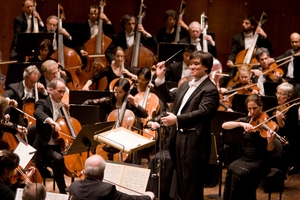
New York Philharmonic publicity photo
photo by Chris Lee
Here it is, I thought, as the New York Philharmonic finished an encore of Stenhammar’s lovely chorale-like “Interlude from ‘Sangen’“ Sunday afternoon at Hill Auditorium: a top-notch visiting orchestra that doesn’t need to play “The Victors” to woo hearts and show the love.
Wrong. Back onstage came Conductor Alan Gilbert, with a blue baseball cap with a big maize M blaring like a trumpet above the brim; up rose the brass to blaze our local chorale. But with what panache: one verse only, with Gilbert taking a seat on the “bleacher” (aka the podium) facing the brass, as if he were in the Big House, not the Big Hall. I call that style. And style was something the entire concert, the second of two New York Phil appearances this weekend under University Musical Society auspices, had very much going in its favor.
The second of the Phil’s two concerts - part of a broader residency that included master classes and lectures - was, in a sense, about getting with the program - that’s program as in program music, pieces that have an extra-musical element, a story explicit or implicit. All three works on the bill - Mussorgsky’s “Night on Bald Mountain;” Bloch’s “Schelomo” (with cellist Jan Vogler); and Tchaikovsky’s Symphony No. 6 in b minor (“Pathetique”) - write their narratives in a bold hand, albeit in differing musical languages. To the Phil, then, to read the narratives aloud for us.
What united the concert, from the Mussorgsky’s witches’ Sabbath to Bloch’s singing lamentation for a war-torn world and Tchaikovsky’s emotionally charged “Pathetique,” was the sense of restraint - in the very best sense - that Gilbert, soloist Vogler and the orchestra, brought to the program. They were willing to wear hearts on the sleeve, display full emotion - but the costume itself was never gaudy, never de trop.
In the “Pathetique,” that meant that pathos never became bathos or bombast. Essences were what the symphony was all about: a lyrical first movement theme full-throated but far off and drawing nearer; a march that was resolute and bold but not brassy; sighs that exhaled like a tide pulling the water back from shore; music that, at the end, passed from section to section, withdrew from us, finally inaudible and then silent. It was a spacious “Pathetique,” compelling, too - amazing how no one in the audience even tried to applaud after the third-movement march, and then how Gilbert could stave off the final applause through the last notes of silence in the finale. And it was filled with stunning playing - from all, but perhaps especially the winds, and especially bassoonist Judith LeClair and clarinetist Mark Nuccio.
Bloch’s program for “Schelomo: a Hebrew Rhapsody for Violincello Solo and Orchestra” may have been post hoc, though the piece was inspired by Ecclesiastes. But the sense of speech and song - with the cello as speaker of the house, in the role of Solomon - is potent and communicative. There’s no text, though Bloch initially considered text and a singer in the solo role. Still, melisma permeates the piece as if it was still sung; stutter tones recall the shofar’s call at the Jewish New Year. Both contribute to “Schelomo’s” Hebraic character.
Vogler, who has known the piece since childhood, sang with feeling, most impressively, perhaps, in the resonant, burry baritone range he produces on his Strad cello. The orchestra was in the background, but essential, for one of the work’s highlights, a section in which the cello is almost alone, as if in personal meditation.The orchestra, low behind it, playing as one group, provides color that translates as individuals approaching to share the cello’s lament - a balm for grief experienced in solitude.
If one of “Schelomo’s” quieter moments was a highlight of the piece, it was also thus with Mussorgsky’s “Night on Bald Mountain,” offered here in the Rimsky-Korsakov arrangement. Not that the opening, with its dark, low brass and winds intoning a wild dance, wasn’t exciting. There was a let-down in energy shortly after that - it was one of the few times in the afternoon when you could make a shopping list, if you needed to. But soon enough, the playing was once again riveting. It became still more so as chimes sounded and darkness ebbed, sapping the Satanic revels. Gilbert’s pacing was perfect, and so was the playing of the winds that gave the piece its serene close.